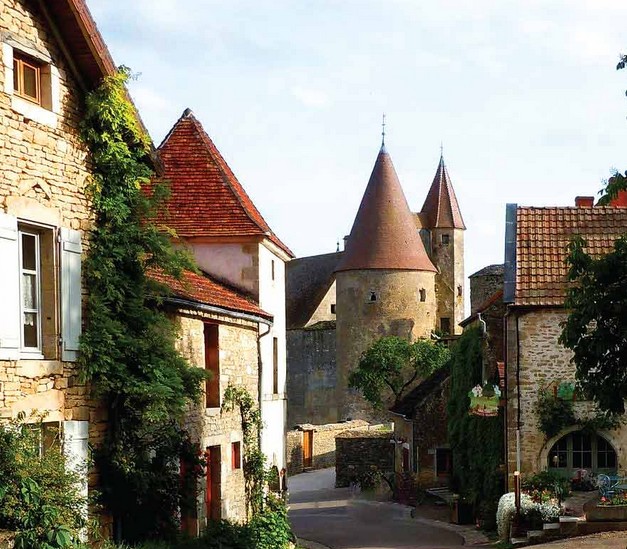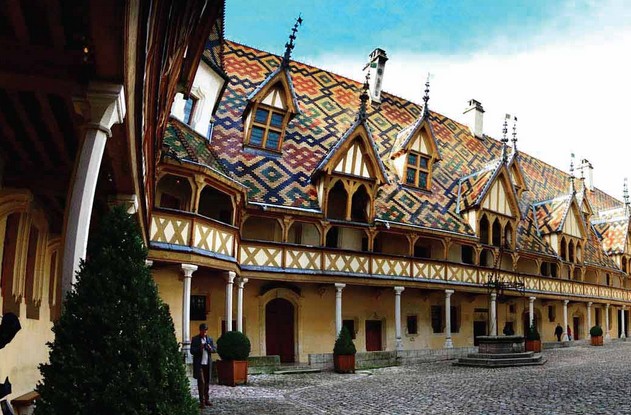Burgundy
India Outbound
March-April 2014
If there is one area in France the term ‘art de vivre’ is applicable then it is Burgundy. Rich in culture, history, gastronomy, world famous wines and all interspersed with beautiful scenery makes it’s a perfect destination where history and gastronomy unite. Take a walk to discover France’s best kept secret.
When thinking about France, Paris, Cannes festival in the French Riviera, or even skiing in the Pyrenees Mountains come to mind. Of course, we all want to visit France’s most famous monument, the well-known Eiffel Tower, and maybe bump into a film star at Cannes… But France is much more than just that.
Less than two hours away by train from big, busy Paris, we find Burgundy, a historical region located in east-central France, and an undoubted paradise for nature, architecture and wine lovers. From north to south, Burgundy is a vast and varied territory which covers four French departments, each offering a unique experience, whether you are looking for a shopping trip, an exciting adventure in nature or just a calm holiday enjoying green fields and wine tastings.
Follow the owl
Burgundy is located halfway between Paris, Geneva in Switzerland and Lyon, in the south of France, all home to international airports. Once there, you can take one or several trains to reach the different points of the region, but renting a car remains the best option, as it allows you to move freely around Burgundy and explore it at your own pace.
Our visit starts at Dijon, historic and modern capital of the Burgundy region. The city, with a population of over 150,000, and welcoming more than 300,000 tourists per year, is the perfect combination of ancient art and architecture, and modern buildings, shops and bars.
“You just need to follow the owl,” says the charming lady at the Tourism Office when asked where to start visiting the city center. At first surprised, we go out and do as we are told: we look for the first owl. And there it is. We start following the owls, sometimes in form of arrows to indicate the route, sometimes with a number. Twenty-two in total, each number indicates a place of interest, making you discover wonders such as the Porte Guillaume, a beautiful triumphal arch from the XVIII century, or the Notre Dame church, a magnificent and unique gothic church dating back to the XIII century. Another stop is the Halles, an important and crowded covered market where you can shop fresh fruits and vegetables, or even some fresh flowers, very à la française! If you start to get hungry, looking for a place to eat is no problem at all: Dijon offers a large variety of little restaurants proposing daily menus for reasonable prices. Whether you are a meat, fish or vegetables person, always accompany your dishes with some Dijon mustard, the world-famous mustard made with white wine.
The visit continues with a walk around Rue de la Liberté, one of the main shopping streets in Dijon. Mesmerized, we forget the owls for a moment, as we discover hundreds of shops to choose from: small, chic boutiques, big brands, clothes or food… There is something for everyone! When the night starts to fall and the buildings start to light up, the city reveals a really beautiful sight. Slowly walking back, we take a last look at the Maison aux trois visages, the stunning half-timbered house listed as historic monument since 1971.
A land of castles
Burgundy is full of surprises. Land of dukes and nobles, its rich heritage can be observed through the incredible castles and small palaces, private or public, which can be visited all over the region. Bussy-Rabutin, embedded among valleys and vineyards, is a true witness of the aristocracy from the last centuries. Dating from the XII century, the castle is classified as historic monument since 1862. The most famous owner was Roger de Bussy-Rabutin, general of the army of Louis XIV, among other things. Satiric and libertine, Roger de Bussy-Rabutin wrote the satirical lampoon Histoires amoureuses des Gaules, in which he mocked some people from the court and the king’s first loves. The king Louis XIV did not appreciate the gesture, and because of this, the general was first locked up in the Bastille and then exiled to this Burgundy castle, where he spent the next 17 years of his life. But his work was so well written that at the same time he became a member of the Academie Française. During his stay at the castle, and to illustrate his day-to-day, he wrote his memoirs, a very valuable document today, and painted different portraits and frescos accompanied by some ironic comments. While visiting the castle’s vast rooms and its magnificent gardens, one travels back to the past imagining the adventures and misfortunes of the nobility during the centuries.
Going south we can also visit the castle of Châteauneuf, a medieval construction from the XV century reigning on top of a hill. During the French Revolution, all symbols of the fortress were destroyed and the castle passed from hand to hand until it became one of the French state protected historic places. The village, Châteauneuf, is also declared one of France’s most beautiful villages. Less than ten minutes away, we discover the inhabited castle of Commarin, primarily an ancient roman village. It has always belonged to the same family, which has renovated the building and its art through the decades. Its perfect condition on the outside is explained by the fact that Commarin was undamaged during the Revolution and during other wars. When visiting the inside, we can still find the rich decorations and a unique collection of tapestries. Of course, right in front all these castles, we can find a vast variety of restaurants and guesthouses to take our time and enjoy a complete traditional stay.
World-renowned wine capital
One of the main and most famous villages around the Dijon area is Beaune, considered the capital of the Burgundy wines. Primarily not a tourist destination, today it attracts thousands of tourists thanks to its wine heritage. As we enter the town and we approach the centre, we can see one more time the mixture of old and historic buildings with new constructions, a view which transports us to another era. Starting to walk around the pedestrian streets, a traditional shopping area where most shops, cafés and small markets are open all day, our head turns in every sense: down to the floor, to appreciate the paved streets, or up to the sky, to take a look at the different, very well conserved, tiled roofs. Our feet lead us to the main attraction in Beaune: the Hospices. A former charitable hospital, the Hospices is now a museum where we can discover how the hospital worked back in 1450. At the main patio, we stare at the most beautiful tiles we have ever seen, a masterpiece of color and geometrical shapes, such a spectacular view… When we enter the building, the ambient surrounding us give us thrills; the air is thick, furniture is ancient, people are quiet… Walking from one room to another, we can imagine how it was to be there as a nurse or a patient back in the day.
But Beaune is not only a fairytale little town. The Hospices are also one of the most, if not the most, famous wine auctions in the wine world! The visit wouldn’t be complete without discovering all the wine cellars that lie beneath the city and signing up for one or two wine tastings… Trying out a Hautes-Côtes de Beaune or a Beaune Premier Cru while savoring some cheese or a delish dinner in one of the various restaurants around town is the perfect activity before going to bed and prepare for a new adventure!
En route to the past
When moving through Burgundy, one has the option of driving on the fast highways or take the slower and longer, but more beautiful, route des vins (the wine route), a panoramic itinerary where one can enjoy the spectacular views of vineyards and hills while crossing small, picturesque villages. For us, taking our time driving to our destination is as enjoyable as arriving there: it is all part of the travel.
With this philosophy in mind, the medieval castle of La Rochepot is a nice stop before reaching our next destination, Cluny. This XII-century fortified castle of neo-Gothic style has been in constant renovation for the last 25 years. Built over the remainders of the old castle, it allows us to visit the different spaces, where we can see the imposing guard’s room, big enough to fit the entire population of the village… The forest around the structure also hides a secret: the ancient ruins of the old castle survive among trees and stones.
The best season for visiting Burgundy is autumn, when the leaves are falling and the vineyards are colored with different shades of red and yellow, and Cluny is one of those villages which are especially beautiful in autumn. It is a small but vibrant medieval city located almost in the middle of nowhere. Well known for its Benedictine Abbey, today it welcomes hundreds of tourists who want to visit this property and are looking for a peaceful break in the countryside. The town was built around the abbey and is very well conserved: taking a stroll through its prestigious historical and cultural heritage is well worth the trip. Most ramparts, gates and towers remain, and by walking around the different ruins dispersed around the town, one goes back in time plunging into the medieval era and envisioning the daily activities locals carried away in Cluny.
Without doubt, the Benedictine Abbey is the star of the show. Founded in 910 and built in the Romanesque style, it was the largest church in Christianity. In 1562, many valuable manuscripts were destroyed by French Protestants, and in 1790, during the French Revolution, the abbey was sacked again and destroyed, only a small part of the building surviving. Today, we can enter the abbey and visit all the renovated parts. There are guided tours in various languages, as well as an incredible state of the art 3D film which shows us how the church was built, its surroundings and its colossal size. One of the many anecdotes we can hear related to the abbey is that Umberto Eco, the Italian writer of the great novel The Name of the Rose, chose this title from a verse written by Bernard of Cluny, a 12th century Benedictine monk who lived there.
All in all, while visiting Burgundy, you will find yourself travelling across a countryside spattered with history in the form of monuments, nature or ruins of all kinds. Whether you are visiting by train or by car, you will be carried along by the unique experience of discovering the life of French monks, kings or doctors who made history in the country. So make yourself comfortable, and let the voyage to the past begin.














